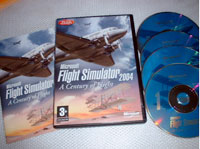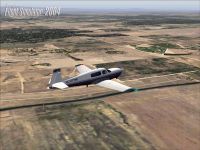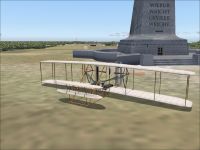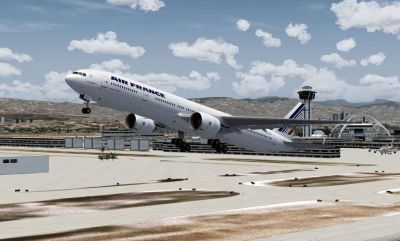Microsoft Flight Simulator 2004 was released on Sep 29th in July 2003. Ninth in the series, its full name is Flight Simulator 2004: A Century of Flight but it is commonly known as FS2004. The concept was to take a look back at the entire history of aviation as a tribute to the Wright Brothers’ first flight 100th anniversary. MS FS2004 also marked the 20 year anniversary of the Flight Simulator franchise.
Image showing Microsoft Flight Simulator 2004 packaging compromising of instruction manual, DVD type case and 4 CD-ROM's.
It ships with historical airplanes such as the 1903 Wright Flyer, Curtiss “Jenny,” Vickers F.B. 27A Vimy, “Spirit of St. Louis,” Ford Tri-Motor, Lockheed Vega, DC-3, deHavilland “Comet,” and Piper Cub.
Improvements over FS2002 include
- Much improved weather engine with clouds in three dimensions. You have a local weather option (the program mimics real time weather) and the ability to program data from weather stations around the world.
- Complete Jeppesen NavData with ILS (Instrument Landing Service), VOR (Very High Frequency Omni-Directional Range), NDB’s (Non-Directional Beacons), varied altitude airways, and more.
- Cockpits with interactive elements including IFR (Instrument Flight Reading) panels with controls and instruments located in one place.
- 24,000 airports around the globe. This is an additional 2000 from FS2002.
- Multiplayer that can be set up locally or over the internet.
- Flight planners that reflect real-world VFR (Visual Flight Rules) and IFR (Instrument Flight Rules) plans.
- Flight recording that allows a player to play back a flight and observe flight data and ground tracking.
- Ability to link two PCs so that one player can act as instructor. The person in the instructor role can change weather, add new elements, give commentary and help through the chat system.
- Enhancements like AutoGen ground structures – farm buildings, traffic lights, street scenes and airport runway and taxiway signage.
- 3D cockpits with the ability to tune radios and adjust controls with point-and-click.
- For users with more computer power, FS2004 provides graphics acceleration that can be seen on multiple monitors.
- Improved Air Traffic Control with traffic from every airport in the system (even air fields with no tower). Now users can experience both precision and non precision approaches, altitude changes, IFR clearances, and more “real world” action.
- True GPS from Garmin – real-time color maps that are constantly updated. They also read out the latest airport information.
Aircraft Included
FS2004 includes 9 vintage and 15 contemporary aircraft.
Microsoft Flight Simulator 2004 official promotional screenshot showing default aircraft flying over countryside.
Vintage Aircraft
- 1903 Wright Flyer
- Curtiss JN-4D "Jenny
- Vickers F.B. 27A Vimy
- Ryan NYP "Spirit of St. Louis
- Ford 4-AT-E Tri-Motor
- Model 5B Vega from Lockheed
- Douglas DC-3
- deHavilland DH-88 Comet
- Piper J-3C-65 Cub
Contemporary
- Beechcraft Baron 58
- Beechcraft King Air 350
- Bell 206B JetRanger III
- Boeing 737-400
- Boeing 747-400
- Boeing 777-300
- Cessna Skyhawk SP Model 172
- Cessna Skylane Model 182S
- Cessna Caravan C208 Amphibian
- Cessna Grand Caravan C208B
- Extra 300S
- Bombardier Learjet 45
- Mooney M20M "Bravo"
- Schweizer SGS 2-32 Canadair CL415
In 2004 Microsoft released a service update that corrected 160 bridges that were either missing or were rendering incorrectly. Other improvements and updates were included.
Vintage
The antique aircraft in FS2004 are tough-to-fly. The Wright Flyer, complete with gauges strapped to the frame, is included. You can also try out the “Spirit of St. Louis” which Charles Lindbergh flew across the Atlantic to France in his historic flight. It has a unique design: to make the plane as streamlined as possible they removed the front windows. The only way to see forward was through a periscope or to stick your head out the side window.
Screenshot of the Wright Flyer next to the Wright Memorial at Kitty Hawk in Microsoft Flight Simulator 2004.
You can also fly a Lockheed Vega, used by Amelia Earhart flying across the Atlantic, the Sopwith Camel civilian flight simulator, or try transporting goods with a long-haul DC-3. Not only can you fly vintage airplanes, you can fly the historic routes of the famous flights taken by the Wright Brothers, Lindbergh, Earhart and more. They are relatively difficult to learn for beginners. Experienced flyers will have a faster learning curve.
Any flight simulator is a challenge to fly with just a keyboard. The older aircraft are even more difficult to fly due to their design. For example, the Curtiss Jenny is a tail-dragger that takes a certain amount of finesse to bring down properly. For that reason, most experienced users will recommend the use of a joystick at a minimum. A yoke with rudder controls is even better. Many of the older planes are hard to maneuver in turns without some serious rudder wrenching.
There are two helicopters in the line-up. The new entry is a Robinson R22 Beta, which joins the well-known Bell JetRanger. The Beta is more of a hyperactive little puddle jumper compared to the larger, smoother JetRanger, another good reason to have rudder controls at the ready.
Game Play Touch and Feel
The feel and touch of FS 2004 has not changed much from Flight Simulator 2002. Most of the commands are the same. That is actually an advantage when flying the vintage aircraft. They are slower and don’t respond quickly like newer, modern planes. As a result, they fit in well with the FS2004 modeling algorithms, steady and reliable but not overly spectacular.
Experienced players recommend playing with at least a joystick and preferably a yoke with rudder pedals. Yokes can be purchased for $100USD and up. A yoke with throttle runs around $130USD and up. Joysticks are more reasonable at around $30USD.
FS2004 can be difficult for first time players. Microsoft has taken steps to help beginners with a series of videos from certified flight instructors. There are also multiple tutorials and the ability to adjust the difficulty levels. Users should expect that the menus can be intricate and take some time to learn.
In the Box
The packaging includes a small booklet detailing the history of flight. This is not the main user manual. The main user manual can be printed out or simply accessed within the program or at the program website.
On the back of the history of flight booklet is a chart of keyboard commands for players with no access to a joystick or yoke. Commands include Pause, Full Screen Mode, Circle Views, Change Simulation Rate, ATC Menu, Engine Start, Increase/Decrease Throttle, Increase/Decrease Propeller, High Display, Lean/Enrich Mixture, Landing Gear Up/Down, Retract/Extend Flaps, Slew Mode (allows you to reposition), On/Off, etc.
The program itself comes on 4 disks. Disk 4 is needed to play the program. For example, you can’t take it to a friend’s house and play it there if it is on your machine at home. You need to install all 4 disks and the 4th disk must be in the machine at all times during play.
Weather
Many users cite the improvements in weather handling as the best game improvement from FS2002. Users can choose weather “themes” that will unfold a series of preset weather conditions as the flight progresses.
FS2004 can also draw upon real time weather conditions pulled from the web. Users can choose local weather to mimic conditions happening outside their window. Thunderstorms, snowstorms, fog, rain, sleet, sunshine, cold fronts and more are available at the click of your mouse.
You can also tell the system to use the real time weather of whatever airport you are flying into or departing from. Improved graphics detail realistic precipitation, cloud formations and storm fronts.
Flight Training
A comprehensive learning center offers flight training including the complete theory of flying. This is a good place to practice if you want to be a pilot. In fact, many flight schools recommend their students use it on a regular business.
You can get extensive pilot training. The system takes you from Student to Soloing, to Private Pilot training to Commercial Pilot. You get full instrument experience from FAA Certified Flight Instructors.
The training is also productive for current pilots wanting to stay sharp behind the controls. You can practice flying at night. Or you can practice holding patterns, approaches, bad weather flight, instrument flying, ending failures, missed approaches, etc.
Pilots can pre-fly routes on FS2004 using real world weather and flight plans. It’s a good way to practice IFC (Instrument Flight Control) procedures like VOR (Very High Frequency Omni-Directional Range) holds.
The learning center is supported by extensive documentation including a Key Topics guide, links to flight lessons, how-to’s, handbooks, briefings, etc. Enthusiastic players may want to get copies of both FAA publications Airplane Flying Handbook (FAA-H-8083-3A) and Pilots Handbook of Aeronautical Knowledge (FAA-H-8083-25A) to help increase flying expertise and provide a deeper background in aeronautical intelligence.
System Compatibility
Here are the system requirements on the box:
- Microsoft Windows 98/Me/XP/2000
- PC with 450 MHz equivalent or higher processor
- 128 MB of system RAM for 2000/XP, 64 MB RAM for 98/Me
- 1.8 GB available hard disk space
- 4x speed or faster CD-ROM drive
- 8 MB video card required
- Sound card, speakers or headphones required for audio
- Microsoft Mouse or compatible pointing device
- 56.6 Kbps or better modem for online play
FS2004 has been found to be very versatile, working well on many machines, even those with low memory or slower video cards. While terrain and water imagery is much improved, buildings and other structures still retain a primitive look similar to FS2002. The advantage is that players using all types of machines can run the program. Many people still stick with FS2004 - some prefer it over FSX.
Community Contributions
One of the real strengths of FS2004 is the way the flight simulator community has embraced the program and developed thousands of freeware (and payware) add-ons.
FS2004 can be operated at a higher frame rate than many newer flight simulators so graphics can be rendered more accurately. It is easier on many computer systems, allowing more users to enjoy it and subsequently develop add-ons for it.
Image shows an Air France Boeing 777 being flown in Microsoft Flight Simulator 2004. This is an add-on, not one of the default aircraft. You can get a great Boeing 777 download for FS2004 here.
The community has developed many extras including scenery, cockpit panels, ATC exchanges and landscapes. You can also find additional aircraft, cars and boats. This is especially attractive for FS2004 as it did not ship with as wide a variety of aircraft as FSX.
With user add-ons you’ll get fighter jets and other aircraft types not seen in the original package.
Most add-ons come with simple instructions to install them. All you need to do is download and go.
There are also quality payware options--companies like PMDG offer additional aircraft and other programs like a 3-part Ground Training Course.
You can view our download sections for FS2004 here.
User Feedback
FS2004 enjoys good ratings from around the web. Dissatisfied players indicate that it does not seem much different from FS2002. For the majority, however, the improvements are enough to add much more functionality and fun to the experience. Other dissenters are impatient with Microsoft’s security measures and the need to keep Disk 4 in the computer during game play.
However, dissenters are in the minority. It is not uncommon for Microsoft Flight Simulator fans to skip the newer FSX edition completely and go right to FS2004. While the graphics are not as impressive, for many computer systems FS2004 is more stable, reliable and functional.
Conclusion
Flight Simulator is arguably the most popular program in the history of flight simulators. It appeals to many different types of users: pilots trying to keep your skills sharp, students training to become pilots, and casual users who just love flying over the Alps in a DC-3 or trying to land a Boeing 747 in a snowstorm in New York City.
While other programs have surpassed it in graphics, imagery and computing power FS2004 remains a favorite among thousands to this day.



